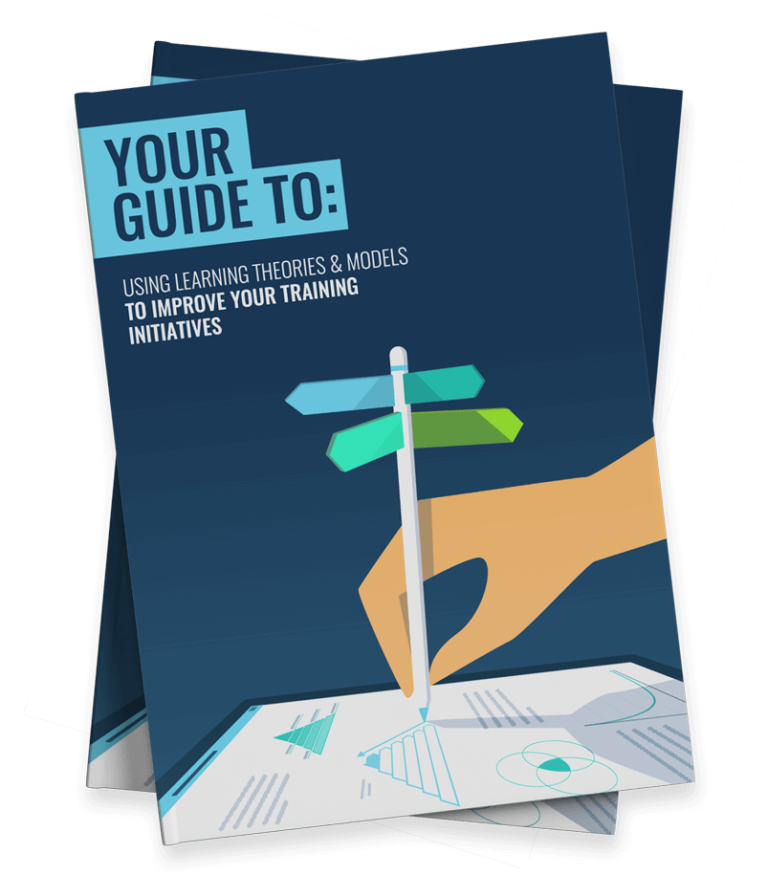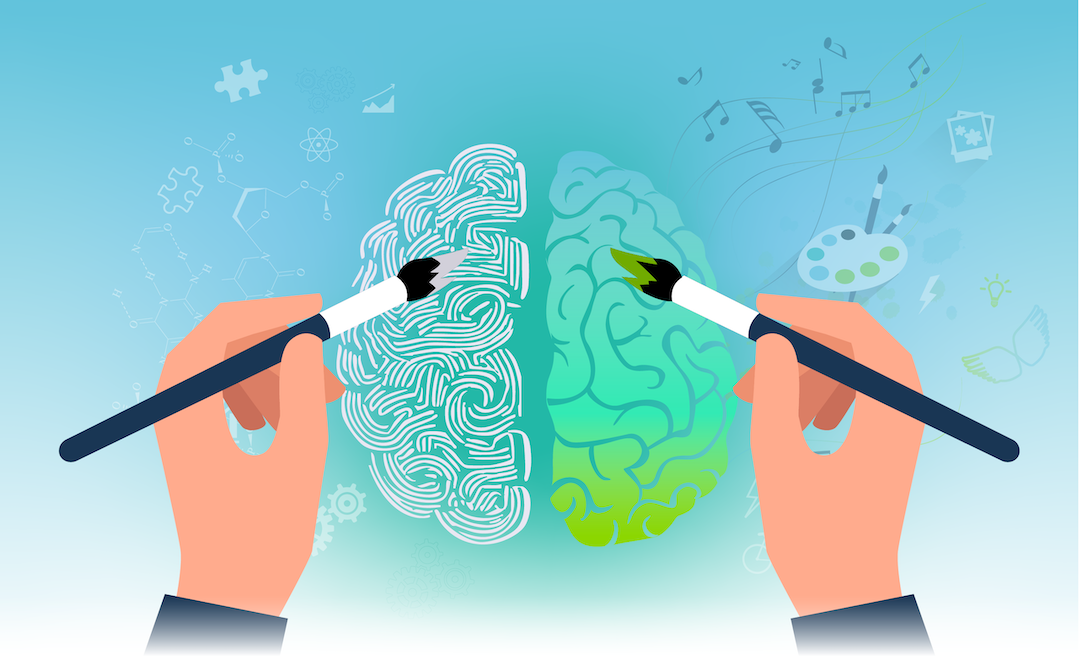
The single biggest roadblock to your learning programme’s success? Engagement.
You can have the fanciest tech, the coolest content, and the most inspiring speakers. But if your learners’ brains aren’t on board, it’s like trying to push a boulder uphill.
And all too often, figuring out why learners aren’t engaged feels like solving a puzzle with missing pieces. Is it the topic? The way it’s presented? Something else entirely? Thankfully, Dr. David Rock’s SCARF model provides us with some much needed clarity.
In this article, we’re going to unpack the SCARF model, look at its five key social domains, and give you a range of practical strategies to get your learners fired up and engaged.
Are you ready? Then let’s rock!
Who is Dr David Rock?
Dr. Rock is an Australian neuroscientist with an awesome name and an even better model of motivation. As the co-founder and CEO of the NeuroLeadership Institute, he leads a global cognitive science consultancy spanning 24 countries.
He’s also authored several books, including the bestseller, ‘Your Brain at Work’, ‘Quiet Leadership’, and ‘Coaching with the Brain in Mind’. As a result, he has now established himself as a recognised thought leader in neuroscience-backed organisational change.
He’s perhaps best known for developing the SCARF model, which we will now explore.
Introducing the SCARF Model
First developed in a 2008 paper, the SCARF model is a neuroscience-based framework that explains how social interactions impact the brain, influencing motivation, behaviour, and decision-making.
As Dr. Rock himself puts it, ‘understanding these drivers can help individuals and organisations to function more effectively, reducing conflicts that occur so easily amongst people’.
He also notes that ‘an approach response’ (when SCARF domains are satisfied), is ‘synonymous with the idea of engagement’. After all, it points to ‘more creative ways of motivating that may not just be cheaper, but also stronger and more sustainable’.
Not bad, right? In essence, we have a model for understanding and engineering engagement that is based on two key assumptions:
- Firstly, we’re wired to chase what feels good and avoid what feels bad — whether it’s a bonus at work or an awkward conversation.
- And secondly, our brains treat social connection like survival. That means feeling valued or left out can hit just as hard as hunger or thirst.
Threat vs Reward
In other words, social interactions trigger either a threat (negative) or reward (positive) response in our brains. You could think of this as a kind of social behaviorism with a neurological twist. Let’s dig a little deeper into these responses:
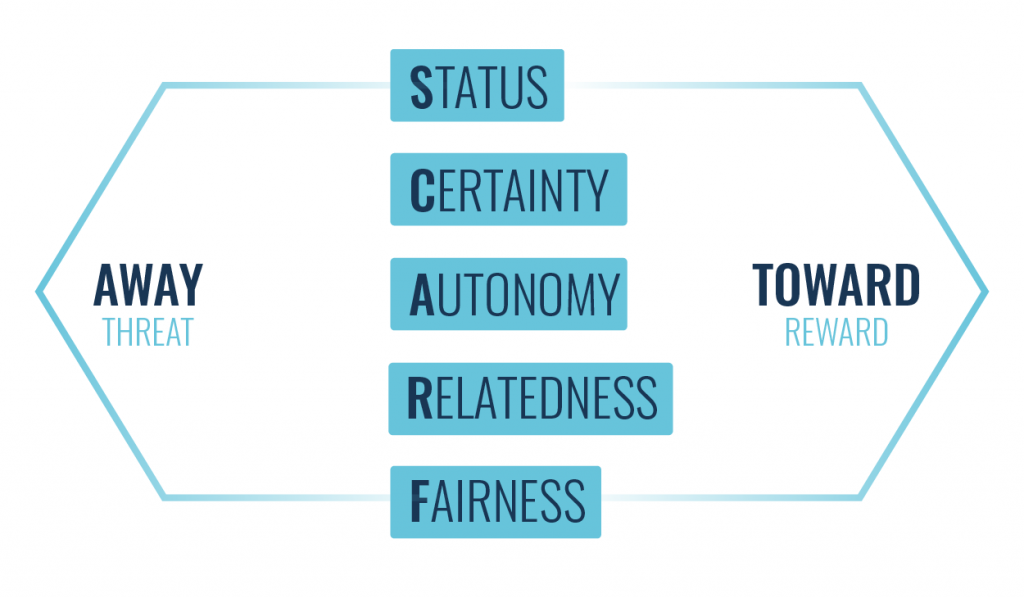
- Threat: Think of ‘threat’ as your brain’s in-built alarm system. It’s any experience that prompts negative emotions, from fleeting anxiety to deep sadness or even chronic stress. Your brain treats these experiences as red flags, urging you to avoid or resolve them.
- Reward: Conversely, ‘reward’ is your brain’s green light. It’s the positive, dopamine-fuelled jolt you get from anything that feels fulfilling, exciting, or meaningful. These emotions don’t just feel good, they motivate you to seek more.
Picture this: You’re an early human on a vast savanna 200,000 years ago. A lion emerging from the tall grass would trigger a vastly different brain response than spotting ripe fruit in a tree. Let’s break down these different reactions:
| Threat Response | Reward Response | |
| Body: | Blood rushes to muscles so the brain gets less fuel | Blood flow boosts the brain and mental energy surges |
| Thinking: | Creative pathways shutdown and fewer ideas are generated | Creativity sparks and new ideas and insights start flowing |
| Mindset: | Stuck in the ‘now’ and in problem-solving mode | Big-picture focus with the ability to plan and innovate |
It’s easy to see which response would lead to better learning. With this established, let’s explore the five social drivers of human behaviour.
The Five Domains of the SCARF Model
Dr. David Rock identified five key social domains that shape our behaviour and interactions. He also packaged them into the memorable acronym, ‘SCARF’. Let’s dig into these domains, and establish their wide-ranging influence:
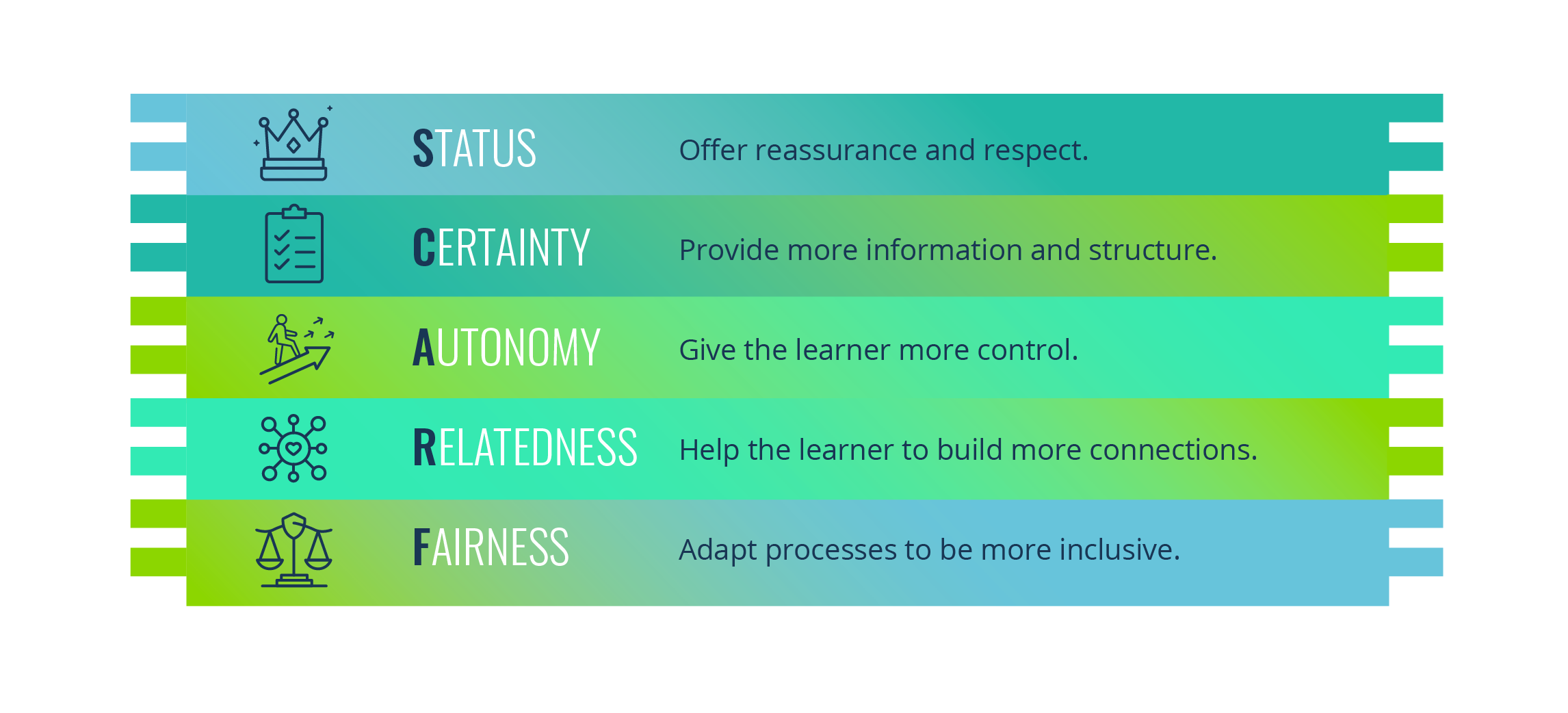
- Status: This is our sense of relative importance or standing within a social group. It’s our perceived position in the ‘pecking order’. A threat to status feels like someone putting you down or disrespecting you. A reward feels like recognition or appreciation.
- Certainty: This is our ability to predict the future, which makes us feel safe and in control. When things are uncertain we feel antsy and uncomfortable. But when we have clarity? That’s when we can relax, think ahead, and plan for the future.
- Autonomy: We thrive when we feel in charge of our choices. But take that away (hello, micromanagers!) and stress soon kicks in. On the other hand, having options and a sense of agency fuels both motivation and satisfaction.
- Relatedness: Our fundamental need to connect with others drives our sense of belonging. Consequently, exclusion activates a threat response in the brain. Likewise, feeling included and trusted activates a rewarding sensation.
- Fairness: Finally, we also consider our perception of justice in social interactions. When we experience unfairness, such as being passed over or lied to, it triggers a threat response. Conversely, transparency and impartiality are rewarding.
Now remember, according to Dr. Rock’s research, our brains react to these social needs with the same intensity as they do to our primary survival needs (like food and water). This distinctly anti-Maslow lens reveals the strong motivational impact of these drivers.
This model can also help us to identify the potential source of issues. For instance, if a learner’s experience seems positive across status, certainty, autonomy, and fairness, it suggests that the difficulties they’re facing may stem from their sense of relatedness.
For learning professionals, this information isn’t just interesting, it’s essential. Which brings us neatly to our next section…
Why is This Relevant to Learning Professionals?
So, what does this mean for you — the educators, trainers, and learning pros who are out there shaping minds every day? It’s simple: the SCARF model is your secret weapon. It reveals the hidden triggers that make learners either shut down or lean in. Here’s how it helps:
- Learner Motivation: As we’ve seen, learners are inherently driven to avoid threats and seek rewards. Transferring this into a learning context helps us to understand how we can motivate our audience and preemptively address potential roadblocks. It’s like someone handing you the cheat codes for a successful learning programme.
- Safe Environments: Your learners can’t perform at their best if they’re not operating within a comfortingly safe environment. The SCARF model gives you the blueprint you need to create your own learning utopia, fuelled by the perfect balance of status, certainty, autonomy, relatedness, and fairness.
- Better Experiences: Think about how good it feels when you’re in a positive and rewarding situation. That same feeling in your learners can unlock a real boost in their mental energy, get their creative juices flowing, and help them connect the dots in a way that makes learning really stick.
- Change Management: Let’s not forget that learning often involves change, which can trigger threat responses. After all, our sense of ‘certainty’ is at risk. Thankfully, the SCARF model can help us to understand why our learners might feel this way. In turn, we are then better placed to address their concerns and adjust to their needs.
Ultimately, the outcome of all this will be better engaged learners who are primed to unleash their full potential. Now that’s a goal worth pursuing! Indeed, compelling research highlights the SCARF model’s tangible benefits across both education and workplace settings. For instance:
- A 2022 study established a clear connection between SCARF-based motivation strategies and improvements in student performance.
- Likewise, this 2023 study shows how educators successfully applied the SCARF framework to reintegrate students into classroom environments post-pandemic.
- And the latest 2024 research reveals a direct link between addressing SCARF domains and improving employee engagement.
Next up, we’ll explore how you can master the threat-reward balance across all five SCARF domains.
Designing Effective Learning Experiences with the SCARF Model
As learning professionals, it’s our responsibility to manage our learners’ reactions across these different domains. While we can’t control every outcome, we do hold the power to design environments where every learner can thrive.

1. Status
Status matters. Indeed, when your learners feel respected and capable, their brains light up for learning. While healthy competition has its place in a learning environment, you should avoid activities that could make individuals feel publicly inadequate. As such, you’ll need to use leaderboards with caution.
You should also provide opportunities for learners to build their status. This can be achieved through gamification (the use of badges, experience points, levels, etc.) and social features that help your top performers to share their knowledge and reinforce their value.

2. Certainty
Strive for clarity and predictability in your learning journeys. Where possible, avoid making sudden, unexplained changes to your schedule, content, or expectations of your learners. When changes are necessary, ensure they are communicated thoughtfully.
A clear learning objective is the bedrock of certainly. Additionally, regular updates and progress indicators can enhance this sense of predictability. And don’t forget to integrate opportunities for learners to check their understanding throughout the experience.
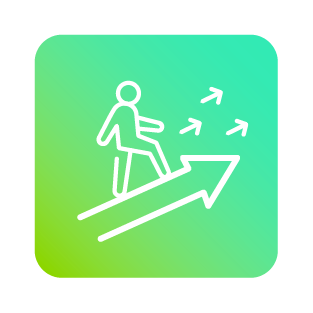
3. Autonomy
As learning professionals, we naturally want to guide our learners and provide them with clear goals. However, being too prescriptive can backfire. Instead of rigid, one-size-fits-all approaches, offer flexibility in how your learners engage with your content.
For example, consider embracing hybrid learning setups and personalised options, where learners can pick their own pathway through your materials. Better yet, invite them to set their own learning goals. This builds ownership and fuels motivation through trust and autonomy.

4. Relatedness
Belonging boosts learning. As such, avoid creating environments that feel isolating or exclusionary. You should also be mindful of how your group work is structured and avoid singling out individuals in a way that makes them feel disconnected from their peers.
Instead, be a community builder. Provide your learners with the tools they need to connect and share their knowledge. Encourage collaborative projects, group discussions, and peer feedback activities. Then you can sit back and watch a vibrant and inclusive learning culture take root.

5. Fairness
Striving for fairness? Ensure all your expectations, evaluation criteria, and rewards are transparent and consistently applied. Any hint of favouritism or bias in your assessments or interactions will rub your learners the wrong way.
Also, really listen to your learners. Give them a chance to provide meaningful feedback about your learning programme. That way, if anything feels unfair (or if something’s just not working), they’ve got a way to highlight it. Then, let them know what steps you’ll take to make things right.
Managing a Threat Response
Even with the best intentions, you won’t always get it right. Mistakes happen and this may trigger a threat response among your learners. When that happens, their engagement levels will plummet. Your job is to recognise this, address it, and get them back on track. See it, say it, sort it!
First up, keep an eye out for the telltale signs of a disengaged learner. These can include withdrawal, defensiveness, silence, agitation, and so on. When identified, acknowledge their concerns fully while working collaboratively to understand the root cause.
Once you know what triggered the threat, address it directly and with care. Avoid downplaying the issue or attempting to refocus on the other social domains. Instead, take decisive action. Example steps might include:
- Status: Offer reassurance and respect.
- Certainty: Provide more information and structure.
- Autonomy: Give the learner more control.
- Relatedness: Help the learner to build more connections.
- Fairness: Adapt processes to be more inclusive.
The priority is to help the learner to feel safe again. Being proactive and showing you care can make a real difference. After the moment has passed, consider checking in with the learner individually to ensure their concerns have been addressed.
The Limitations of the SCARF Model

Of course, no framework is perfect and the SCARF model is no exception. Some critics argue that boiling down human motivation to five key areas might miss some of the nuance in how we really interact and respond to each other.
It also overemphasises social-emotional drivers at the expense of other considerations. For instance, intrinsic interest in the subject matter itself is also likely to prompt learners to take action. The truth is, our motivations are highly context-dependent.
What’s more, each learner will prioritise the SCARF domains differently. A situation that feels threatening to one person might be motivating to another (like their position on a leaderboard). There’s even an assessment you can take to establish your sensitivity.
For learning professionals, this means you’ll need to adapt your approach thoughtfully based on your learners’ needs. But this has always been the case. That’s why we conduct training needs analyses and learner persona exercises.
Despite these limitations, the SCARF model provides an intuitive and valuable way to understand what makes people tick at work or in learning environments. It’s not the whole story, but it’s a great starting point for building better engagement.
Final Words
For L&D professionals, learner engagement often feels like chasing the holy grail. But, it’s not some mysterious or magical force. It’s a predictable brain response waiting to be activated. And thanks to Dr. David Rock, now we know how.
When you meet learners’ core SCARF needs (status, certainty, autonomy, relatedness, and fairness), something amazing happens. They transform from passive observers into motivated participants who are genuinely invested in the experience.
Now, it’s your turn. How will you leverage the SCARF model to revolutionise your learning programmes and truly connect with your audience? It’s time to go forth and engage!
Thanks for reading. If you’ve enjoyed this content, please connect with me here or find more articles here.
Mastered the SCARF model? Don’t stop there! For a complete overview of all the essential learning theories and models, check out our new guidebook, ‘The Learning Theories & Models You Need to Know’.

